最新人教部编版四年级英语下册第六单元let‘s talk B先学后教模式ppt课件
- 格式:pptx
- 大小:49.89 KB
- 文档页数:10
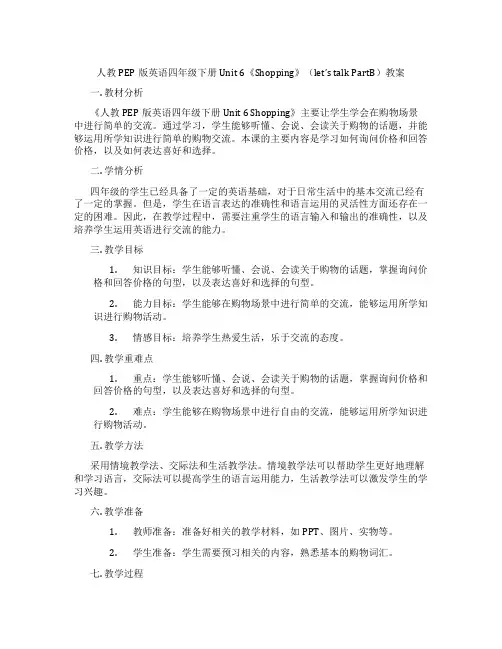
人教PEP版英语四年级下册Unit 6《Shopping》(let’s talk PartB)教案一. 教材分析《人教PEP版英语四年级下册Unit 6 Shopping》主要让学生学会在购物场景中进行简单的交流。
通过学习,学生能够听懂、会说、会读关于购物的话题,并能够运用所学知识进行简单的购物交流。
本课的主要内容是学习如何询问价格和回答价格,以及如何表达喜好和选择。
二. 学情分析四年级的学生已经具备了一定的英语基础,对于日常生活中的基本交流已经有了一定的掌握。
但是,学生在语言表达的准确性和语言运用的灵活性方面还存在一定的困难。
因此,在教学过程中,需要注重学生的语言输入和输出的准确性,以及培养学生运用英语进行交流的能力。
三. 教学目标1.知识目标:学生能够听懂、会说、会读关于购物的话题,掌握询问价格和回答价格的句型,以及表达喜好和选择的句型。
2.能力目标:学生能够在购物场景中进行简单的交流,能够运用所学知识进行购物活动。
3.情感目标:培养学生热爱生活,乐于交流的态度。
四. 教学重难点1.重点:学生能够听懂、会说、会读关于购物的话题,掌握询问价格和回答价格的句型,以及表达喜好和选择的句型。
2.难点:学生能够在购物场景中进行自由的交流,能够运用所学知识进行购物活动。
五. 教学方法采用情境教学法、交际法和生活教学法。
情境教学法可以帮助学生更好地理解和学习语言,交际法可以提高学生的语言运用能力,生活教学法可以激发学生的学习兴趣。
六. 教学准备1.教师准备:准备好相关的教学材料,如PPT、图片、实物等。
2.学生准备:学生需要预习相关的内容,熟悉基本的购物词汇。
七. 教学过程1.导入(5分钟)教师通过播放一首关于购物的歌曲,引起学生的兴趣,然后向学生提问:“你们喜欢购物吗?为什么?”让学生发表自己的看法,从而引出本课的主题。
2.呈现(10分钟)教师通过PPT展示本课的主要内容,包括词汇、句型等,同时进行讲解和示范。
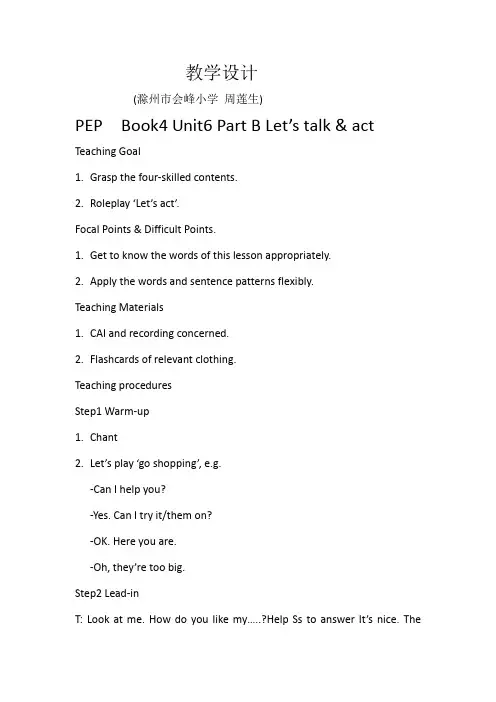
教学设计(滁州市会峰小学周莲生)PEP Book4 Unit6 Part B Let’s talk & act Teaching Goal1.Grasp the four-skilled contents.2.Roleplay ‘Let’s act’.Focal Points & Difficult Points.1.Get to know the words of this lesson appropriately.2.Apply the words and sentence patterns flexibly.Teaching Materials1.CAI and recording concerned.2.Flashcards of relevant clothing.Teaching proceduresStep1 Warm-up1.Chant2.Let’s play ‘go shopping’, e.g.-Can I help you?-Yes. Can I try it/them on?-OK. Here you are.-Oh, they’re too big.Step2 Lead-inT: Look at me. How do you like my…..?Help Ss to answer It’s nice. Thecolour is nice. It’s beautiful. T:Thank you. It’s pretty. I like it, too.Step 3 Presentation1.Present sentence patterns, How do you like….. It’s……2.Talk about ‘Let’s talk’, and encourage Ss to answer: Who can you see? Where’re they?3. Watch the video clip of ‘Let’s talk’, Ss try to choose: What’re they talking about?4.Teach expensive, too expensive and cheap5.Listen to the tape again. Highlight the sentence ‘How do you like this skirt?’6.Ask students to guess the meaning of ‘how much’, contrasting with ‘how many’. Elicit the reply: It’s $89. Help students differ $and ¥,which symbolize U dollar &CNY.Step 4 Practice1.Act out the dialogue in roles. And draw their attention to the stressand intonation .2.Make a new dialogue.Set a real situation with flash. Suppose Children’s day is coming. Let’s buy some new clothes to celebrate it. Let’s act as a shop assistant anda customer. Simulate selling and buying clothing, including a shirt, asweater, pants, socks, a hat, gloves, etc.Let’s play: ‘How much is it?/How much are they?’Ask students toguess at the prices of various commodities.Step 5 Sum up& HomeworkSum up what learnt in this class. Emphasis how to use How much.Step 6 Homework(1)Listen to and repeat “Let’s learn” and “Let’s act”.(2)Try to make a new dialogue according to “Let’s talk”.Teaching reflectionIt’s critical to help students contract and use the two similar key sentences:-How many …(s) are there/can you see/do you have?-…(number) and –How much is…? How much are…?-It’s/They’re…yuan/dollars.。
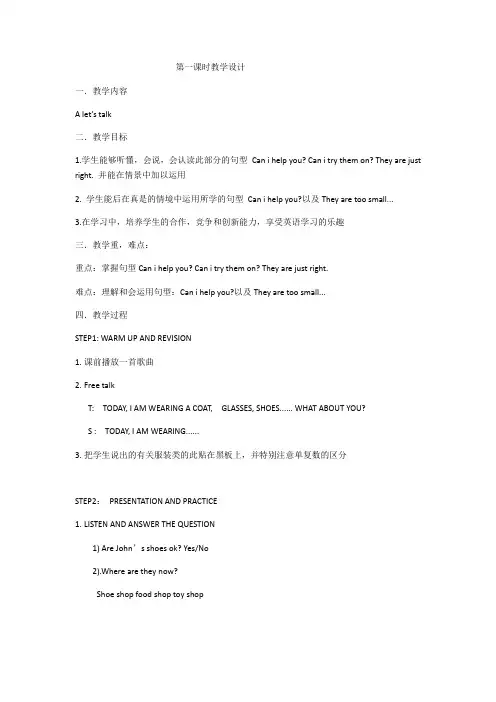
第一课时教学设计一.教学内容A let’s talk二.教学目标1.学生能够听懂,会说,会认读此部分的句型Can i help you? Can i try them on? They are just right. 并能在情景中加以运用2. 学生能后在真是的情境中运用所学的句型Can i help you?以及They are too small...3.在学习中,培养学生的合作,竞争和创新能力,享受英语学习的乐趣三.教学重,难点:重点:掌握句型Can i help you? Can i try them on? They are just right.难点:理解和会运用句型:Can i help you?以及They are too small...四.教学过程STEP1: WARM UP AND REVISION1.课前播放一首歌曲2.Free talkT: TODAY, I AM WEARING A COAT, GLASSES, SHOES...... WHAT ABOUT YOU?S : TODAY, I AM WEARING......3.把学生说出的有关服装类的此贴在黑板上,并特别注意单复数的区分STEP2:PRESENTATION AND PRACTICE1.LISTEN AND ANSWER THE QUESTION1) Are John’s shoes ok? Yes/No2).Where are they now?Shoe shop food shop toy shop2.Listen and find out the answers1.Who’s coming?She’s the shop assistant.2.What does she say?Can i help you?What size are the yellow shoes?They are 6.Are size 6 ok?Now , listen again and find out the answersNo , they are too small. So what size is ok?Can i try them on? Ok.They are just right.3. Pair work:A:Can I help you?B: Yes. These shoes are ….Can I try them on? Size 6,please. A: Of course/OK….Here you are.4.LET’S HAVE A ROAL PLAY5.INTRODUCTION ABOUT HTE DIFFERENT SIZE CULTURESTEP 3 EXTENTION AND CONSOLIDATION1.Shoe SS a video about our school sports meet.2.Group work :Shopping for the sports meet(为运动会购物)3.Let’s make up a talkTasks:A: a shop assistantB:mum/dadC: a studentA: ... .B:Yes.These/It ... are/is... .Can I try... ? Size..., please.A: ... .C:Are they/Is it...?B:They’re/It’s... .A/B/C: ….4.How to deal with the used clothesLet’s have a discussion and give opinions to us.Step 4 homework 作业1.Read the dialogue 3 times(P58).(读58页对话3遍。

小学英语PEP人教版四年级下册《Unit6 At a farm B Let’s talk》教案5一. 教材分析《PEP人教版四年级下册》Unit 6主要围绕农场展开,让学生学习与农场相关的词汇和句子。
本节课为B部分Let’s talk,通过一个关于农场的小故事,让学生学习新的单词和句型,并能够运用所学进行简单的交流。
二. 学情分析四年级的学生已经掌握了基本的英语语法和词汇,具备了一定的听说读写能力。
他们对新鲜事物充满好奇,善于模仿和创造。
在学习了Unit 6的前两部分内容后,学生已经掌握了部分与农场相关的词汇,对于本节课的学习会有很大的帮助。
三. 教学目标1.知识目标:学生能够听懂、会说、会读本节课所学的单词和句子,能够运用所学进行简单的交流。
2.能力目标:通过小组合作、互动交流,提高学生的口语表达能力和团队协作能力。
3.情感目标:培养学生热爱生活,关注自然,珍惜粮食的品质。
四. 教学重难点1.重点:学生能够听懂、会说、会读本节课所学的单词和句子。
2.难点:学生能够运用所学进行简单的交流,并在实际情境中正确运用。
五. 教学方法采用情境教学法、互动教学法和小组合作教学法,通过创设情境、学生互动、小组讨论等方式,激发学生的学习兴趣,提高学生的参与度和积极性。
六. 教学准备1.教师准备:准备好课件、单词卡片、农场图片等教学材料。
2.学生准备:预习本节课的内容,熟记单词和句子。
七. 教学过程1.导入(5分钟)教师通过提问方式引导学生回顾Unit 6前两部分的内容,复习与农场相关的词汇,为新课的学习做好铺垫。
2.呈现(5分钟)教师通过课件展示本节课所学的单词和句子,让学生初步感知和理解。
3.操练(10分钟)教师引导学生进行单词和句子的认读练习,可以通过游戏、竞赛等形式进行,提高学生的学习兴趣。
4.巩固(5分钟)教师创设情境,让学生分角色扮演,用所学单词和句子进行对话,巩固所学知识。
5.拓展(5分钟)教师引导学生运用所学知识进行小组讨论,讨论自己在农场的情景,提高学生的实际运用能力。

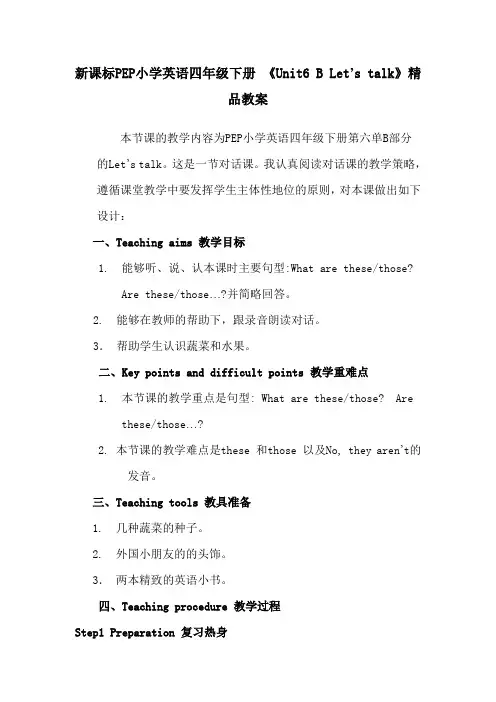
新课标PEP小学英语四年级下册《Unit6 B Let’s talk》精品教案本节课的教学内容为PEP小学英语四年级下册第六单B部分的Let’s talk。
这是一节对话课。
我认真阅读对话课的教学策略,遵循课堂教学中要发挥学生主体性地位的原则,对本课做出如下设计:一、Teaching aims 教学目标1. 能够听、说、认本课时主要句型:What are these/those?Are these/those…?并简略回答。
2. 能够在教师的帮助下,跟录音朗读对话。
3.帮助学生认识蔬菜和水果。
二、Key points and difficult points 教学重难点1. 本节课的教学重点是句型: What are these/those? Arethese/those…?2. 本节课的教学难点是these 和those 以及No, they aren’t的发音。
三、Teaching tools 教具准备1. 几种蔬菜的种子。
2. 外国小朋友的的头饰。
3.两本精致的英语小书。
四、Teaching procedure 教学过程Step1 Preparation 复习热身1.Introduce myself.My name is May.I’m your teacher today.I like tomatoes.They are yummy and great!I don’t like onions.They are white and smelly!(加上节奏做自我介绍,和学生们拉近距离,为课堂营造良好的师生氛围。
)2.Free talk.T:I like tomatoes. They are yummy and great!T: What do you like? Why?S: I like…3.A guessing game.Show a picture of tomato. Then guess: What is it?S: It’s a …Then show another picture of the watermelon. Ask the students to guess.然后引出:What are these? They are…(让学生猜两幅关于水果和蔬菜的图片,既可以让学生的思维活跃起来,又能引出新知识点。
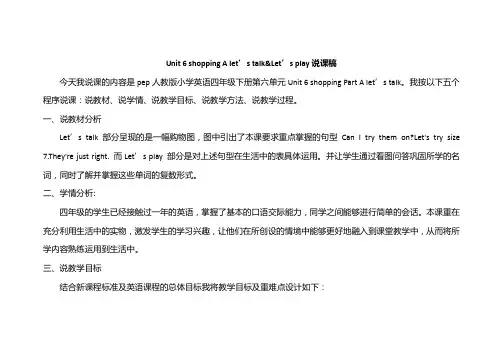
Unit 6 shopping A let’s talk&Let’s play说课稿今天我说课的内容是pep人教版小学英语四年级下册第六单元Unit 6 shopping Part A let’s talk。
我按以下五个程序说课:说教材、说学情、说教学目标、说教学方法、说教学过程。
一、说教材分析Let’s talk部分呈现的是一幅购物图,图中引出了本课要求重点掌握的句型Can I try them on?Let's try size 7.They're just right. 而Let’s play 部分是对上述句型在生活中的表具体运用。
并让学生通过看图问答巩固所学的名词,同时了解并掌握这些单词的复数形式。
二、学情分析:四年级的学生已经接触过一年的英语,掌握了基本的口语交际能力,同学之间能够进行简单的会话。
本课重在充分利用生活中的实物,激发学生的学习兴趣,让他们在所创设的情境中能够更好地融入到课堂教学中,从而将所学内容熟练运用到生活中。
三、说教学目标结合新课程标准及英语课程的总体目标我将教学目标及重难点设计如下:教学目标:1.能够听、说、认读本课时的主要句型:Can I try them on. Let's try size 7.They're just right.2.能够跟录音朗读对话并进行表演。
教学重点:学习新句型:Can I try them on. Let's try size 7.They're just right.教学难点:在情景交际中正确使用本课时的新句型。
四、说教学方法为了有效地达成教学目标,突出重点,突破难点,我采取了以下教学策略:(1)提高学生的能动性围绕新课标以学生为主体的思想,在课堂上教师要肯放手,提高学生的能动性,让学生成为课堂的主体。
(2)兴趣激励利用各种教学手段、方法等,激发学生学习英语的主动性,在鼓励性语言评价中树立学生的自信心,让学生有兴趣说英语,积极参与合作,体验成功感。

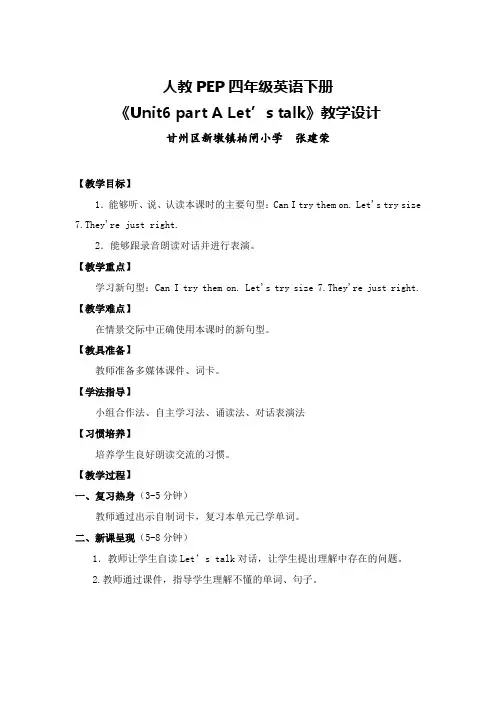
人教PEP四年级英语下册《Unit6 part A Let’s talk》教学设计甘州区新墩镇柏闸小学张建荣【教学目标】1.能够听、说、认读本课时的主要句型:Can I try them on. Let's try size 7.They're just right.2.能够跟录音朗读对话并进行表演。
【教学重点】学习新句型:Can I try them on. Let's try size 7.They're just right. 【教学难点】在情景交际中正确使用本课时的新句型。
【教具准备】教师准备多媒体课件、词卡。
【学法指导】小组合作法、自主学习法、诵读法、对话表演法【习惯培养】培养学生良好朗读交流的习惯。
【教学过程】一、复习热身(3-5分钟)教师通过出示自制词卡,复习本单元已学单词。
二、新课呈现(5-8分钟)1.教师让学生自读Let’s talk对话,让学生提出理解中存在的问题。
2.教师通过课件,指导学生理解不懂的单词、句子。
3.学生结合课文中的情景,分角色表演对话。
教师挑出两双鞋,一双适合自己的脚,另一双或大或小,然后让学生猜哪一双是自己的鞋,引出新句型的教学。
2.教师指导学生做问答练习,然后调查同伴的鞋的号码,进行小组汇报。
3.待学生能够熟悉句型后,教师为学生播放光盘中的课件,让学生感知对话内容,听读、跟读对话内容。
4.学生跟录音朗读课文,教师指导学生朗读。
学生分角色朗读对话。
三、趣味操练(10-15分钟)1.教师播放一段购物的视频录像,孩子观看录像后用自己学过的句子和单词进行描述。
2.小组交流自己看到的内容。
3.创设购物情境,让学生用学过的语言进行模拟购物。
四、运用拓展(5-8分钟)1.听第58页的Let’s talk 部分的录音。
2.读给同伴、朋友或家长听。
五、评价反馈(3-5分钟)让学生说一说在本节学习中的收获。
【板书设计】Unit6:Shopping Part A Let’s talkCan I help you?These shoes are nice.Can I try them on?They are too small.They are too big.Let’s try size 7.They are just riight!。
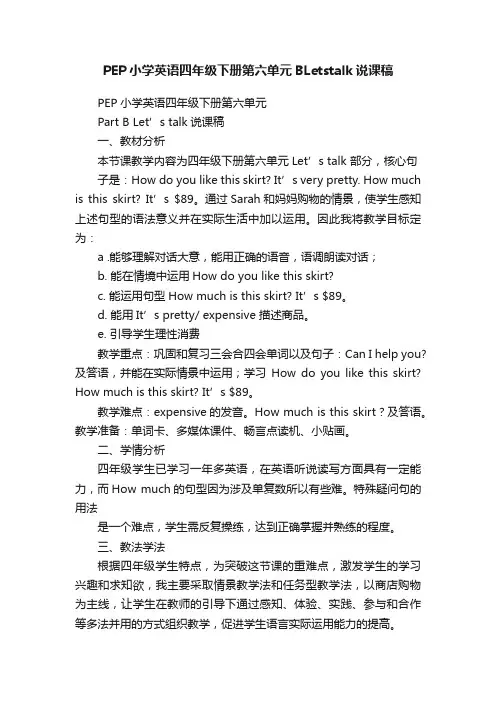
PEP小学英语四年级下册第六单元BLetstalk说课稿PEP小学英语四年级下册第六单元Part B Let’s talk说课稿一、教材分析本节课教学内容为四年级下册第六单元Let’s talk 部分,核心句子是:How do you like this skirt? It’s very pretty. How much is this skirt? It’s $89。
通过Sarah和妈妈购物的情景,使学生感知上述句型的语法意义并在实际生活中加以运用。
因此我将教学目标定为:a .能够理解对话大意,能用正确的语音,语调朗读对话;b. 能在情境中运用How do you like this skirt?c. 能运用句型How much is this skirt? It’s $89。
d. 能用It’s pretty/ expensive 描述商品。
e. 引导学生理性消费教学重点:巩固和复习三会合四会单词以及句子:Can I help you?及答语,并能在实际情景中运用;学习How do you like this skirt? How much is this skirt? It’s $89。
教学难点:expensive的发音。
How much is this skirt?及答语。
教学准备:单词卡、多媒体课件、畅言点读机、小贴画。
二、学情分析四年级学生已学习一年多英语,在英语听说读写方面具有一定能力,而How much的句型因为涉及单复数所以有些难。
特殊疑问句的用法是一个难点,学生需反复操练,达到正确掌握并熟练的程度。
三、教法学法根据四年级学生特点,为突破这节课的重难点,激发学生的学习兴趣和求知欲,我主要采取情景教学法和任务型教学法,以商店购物为主线,让学生在教师的引导下通过感知、体验、实践、参与和合作等多法并用的方式组织教学,促进学生语言实际运用能力的提高。
四、教学过程:一)Warm up1,Greeting2,Do a warm-up【设计意图:集中学生注意力,调动课堂氛围,避免拘束。
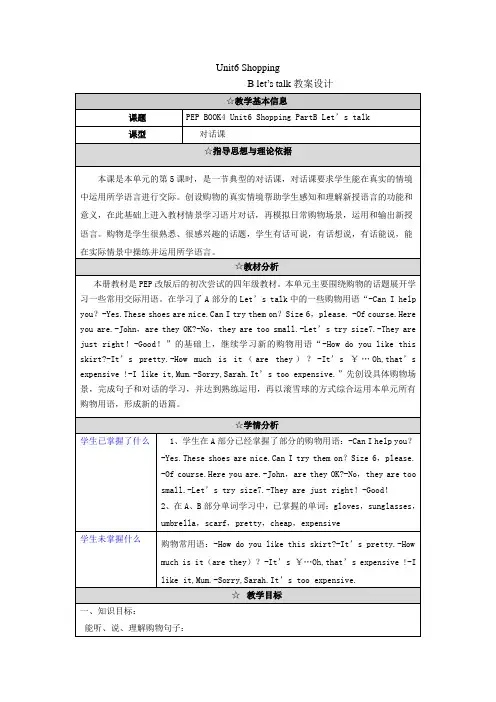
Unit6 ShoppingB let’s talk教案设计☆教学基本信息课题PEP BOOK4 Unit6 Shopping PartB Let’s talk课型对话课☆指导思想与理论依据本课是本单元的第5课时,是一节典型的对话课,对话课要求学生能在真实的情境中运用所学语言进行交际。
创设购物的真实情境帮助学生感知和理解新授语言的功能和意义,在此基础上进入教材情景学习语片对话,再模拟日常购物场景,运用和输出新授语言。
购物是学生很熟悉、很感兴趣的话题,学生有话可说,有话想说,有话能说,能在实际情景中操练并运用所学语言。
☆教材分析本册教材是PEP改版后的初次尝试的四年级教材。
本单元主要围绕购物的话题展开学习一些常用交际用语。
在学习了A部分的Let’s talk中的一些购物用语“-Can I help you?-Yes.These shoes are nice.Can I try them on?Size 6,please. -Of course.Here you are.-John,are they OK?-No,they are too small.-Let’s try size7.-They are just right!-Good!”的基础上,继续学习新的购物用语“-How do you like this skirt?-It’s pretty.-How much is it(are they)?-It’s ¥…Oh,that’s expensive !-I like it,Mum.-Sorry,Sarah.It’s too expensive.”先创设具体购物场景,完成句子和对话的学习,并达到熟练运用,再以滚雪球的方式综合运用本单元所有购物用语,形成新的语篇。
☆学情分析学生已掌握了什么 1、学生在A部分已经掌握了部分的购物用语:-Can I help you?-Yes.These shoes are nice.Can I try them on?Size 6,please.-Of course.Here you are.-John,are they OK?-No,they are toosmall.-Let’s try size7.-They are just right!-Good!2、在A、B部分单词学习中,已掌握的单词:gloves,sunglasses,umbrella,scarf,pretty,cheap,expensive学生未掌握什么购物常用语:-How do you like this skirt?-It’s pretty.-Howmuch is it(are they)?-It’s ¥…Oh,that’s expensive !-Ilike it,Mum.-Sorry,Sarah.It’s too expensive.☆教学目标一、知识目标:能听、说、理解购物句子:1、-How do you like this skirt?-It’s pretty.2、-How much is it(are they)?-It’s(They are)¥….Oh,that’s expensive !3、-I like it,Mum.-Sorry,Sarah.It’s too expensive.二、技能目标:1、能在实际情景中运用熟练以上购物用语。
PEP小学英语四年级下册Unit6 PartB Let's talk 教学设计教学目标:1. 掌握词汇:eat breakfast, drink milk, watch TV, go to school, take a shower2. 能够进行简单的日常交际,向他人展示自己的日常生活。
3. 能够感受到英语语言学习的趣味性和实用性。
教学过程:1. Warm-up(1)GreetingT: Good morning, class!S: Good morning, teacher!T: How are you?S: I’m fine, thank you. And you?T: I’m fine, too. Thank you. Let’s sing a song “Good morning” together.(2)ReviewT: Can you remember what we learned in the last unit? Please tell me.S: We learned “What do you have for lunch?” “I have…” “Wh at time is it?” “It’s…” “What’s the weather like?” “It’s…”2. Presentation(1)Lead-inT: Look at the pictures. What are they doing?S: She is eating breakfast. He is drinking milk. They are watching TV. He is going to school. She is taking a shower.T: Very good. Today, we are going to learn some activities of our daily life.(2)PresentationT: Please listen to the tape and repeat after it. And then, let’s chant together.Tape: Eat breakfast—Drink milk—Watch TV—Go to school—Take a shower.Chant: Eat breakfast, drink milk, watch TV, go to school, take a shower. (x3)(3)DrillT: Boys and girls, do you like to have breakfast? What do you have for breakfast? Let’s make a dialogue with your partner.S1: What do you have for breakfast?S2: I have some bread and milk.T: Okay, let’s have a try with me.T: What do you have for breakfast?S: I have some eggs and milk.T: Very good. Can you make a dialogue in pairs? You can change the words as your like.(4)Role-playT: Now, please stand up, and make a circle. You should introduce yourself to the person next to you. You should talk about: What do you have for breakfast? What do you do after breakfast? What time do you go to school?3. Practice(1)DrillT: Look at the picture, and answer the question.“What is he doing?”S: He is watching TV.T: And what is she doing?S: She is taking a shower.T: Very good. Let’s have a try with me.T: What is she doing?S: She is taking a shower.T: What is he doing?S: He is watching TV.T: Can you do it by yourselves? Try with your partners.(2)Role-playT: Now, please make a dialogue with your partner. You should talk about: What do you do after breakfast? What do you do after school?S1: What do you do after breakfast?S2: I watch TV after breakfast. And you?S1: I go to school after breakfast.S2: After school, what do you do?S1: I take a shower after school. And you?S2: I do my homework after school.(3)InterviewT: Boys and girls, I’ll be a reporter. I’ll come to you, and ask you some questions. Are you ready?S: Yes.T: Okay. What do you have for breakfast?S1: I have some eggs and milk.T: What do you do after breakfast?S2: I watch TV after breakfast.T: What time do you go to school?S1: I go to school at 7:30 in the morning.T: Very good. Thank you for your answers.4. Production(1)PresentationT: Boys and girls, now we can introduce ourselves in English. Let me try.My name is Lucy. I have some bread and milk for breakfast. Afterbreakfast, I go to school. And you?(2)InterviewT: Can you introduce yourself in English? And then, you should ask your partner some questions about his or her daily life. You should use the words we learned today.S1: My name is xxx. I eat breakfast and drink milk in the morning. What do you have for breakfast?S2: I have some cereal and milk for breakfast. What do you do after breakfast?(3)PresentationT: Now, please make a poster about your daily life. You can write the activities you do, the time you do, etc. And then, you should show and introduce your poster to the class.5. Summary & Homework(1)SummaryT: Today, we learned some activities of our daily life. We also learned how to make dialogues, role-play, and interview. Can you tell me what we learned today?S: We learned “eat breakfast, drink milk, watch TV, go to school, take a shower”. And we learned how to talk about our daily life.(2)HomeworkT: Please finish the poster about your daily life. And then, you should share it with your family.。
Unit 6 Meet My FamilyPeriod 2, Part BTeaching Aims:1. Knowledge aim1) Ss can understand, listen, read and say the dialogu e “What’s your father?--My father is a doctor/driver...” and exert them in practical scenes.2) Ss can understand and sing the chant.2.Skill aimAfter learning the sentence pattern the students would be able to make dialogues and ask what do the people around them do for a living.3.Emotional aimSs would be able to learn how to ask information about other people’s job.Key PointsTo grasp the sentence pattern: Is this your …? What’s your …?Difficult PointsTo use the sentence and make dialogues.Teaching Tools:ppt, coursewareTeaching Methods: Task-based teaching method, TPRTeaching Procedures:Step 1 Warm-upGreetings: Hello! My name is Chen Siping. You can call me Miss Chen. Nice to meet you, boys and girls.Let’s sing a song named My father is a doctorToday we are going to learn part B of Meet My family. Family is a beautiful word. Let’s see,F stands for fatherA stands for andM stands for mothe rI stands for IL stands for loveY stands for youDo you want to meet my parents? Now let’s meet together! My father is a soldier. What’s your father? My mother is a teacher. What’s your mother?Let’s doAct like a teacher. Act like a doctor. Act like a nurse.Act like a farmer. Act like a driver. Act like a baseball player.Step 2 Review and previewShow a picture of Yao Ming.T: Who’s this man?S: He’s Yao Ming.T: What’ Yao Ming like?S: He’s tall and strong.T: Right. He looks(看起来)tall and strong. (Read three times)T: What is Yao Ming?S: He’s a basketball player(篮球运动员).Show some pictures and let them say like this He/She/ They look(s) ….Step 3 PresentationNow come and meet my other family members. Let’s gues s who are they by using the sentence Is this your …? / Are they your …?Show a picture of my sisterT: Guess who’s this girl?S: Is this your sister?T: Yes, she is. What’s my sister?S:She’s a nurse.T: Right. She looks(看起来) pretty. Yes or no?Show a picture of my grandparentsT: Look! They are my grandpa and grandma. Guess what are they?S: Are they workers(工人)?T: Yes, you’re right. They look(看起来) old. Yes or no?After meeting my family, let’s go and meet Amy’s family. Listen and answer my questions:Q1: What’s Amy’s uncle?Q2: What’s Amy’s aunt?Q3: What’s Amy’s father?Q4: What’s Amy’s mother?Read together and read groups of two.Step 4 Practice1)Role-play to help the students to practice the dialogues better.2)Let’s chant is designed for the students to practice by repeating the sentences.3)After practicing “Let’s make a chant” the students would be able to know how to use the languageStep 5 Wrap upThe teacher asks “What do we learn today?” so the students will have a chance to sum the class up by themselves.Homework:The students should go home and ask their neighbor what’s your mom/father? Blackboard Layout:What’s your father He/She’s a doctormother nursesister doctoraunt driver。
新编人教版pep版四年级英语下册Unit6BLetstalk教案Unit 6 Shopping B Let’s talk[每日一句] 5. Action speak louder than words.行动胜于言语!学习内容:Unit 6 Shopping B Let’s talk课型:对话学习目标1、能听、说、认、读重点句型:Can I help you? How much is …? How much are …?【要会在使劲情景中运用,语调要自然哦】。
2、能翻译并理解对话意义。
【比比看谁翻译的准确哦】重难点能听、说、认读本课时的主要句型:Can I help you? How much is …? How much are …?学具每组准备一套自制Sarah、Sarah’s mother、Assistant的头饰及skirt的卡片。
预习提点:1.可以查电子词典,听录音或向老师,组长请教Let’s talk 中对话的正确发音,并知道汉语意思。
2.圈出不懂得单词和句子。
小组之间比比看谁翻译的准确,老师进行指导。
3.模拟Let’s act 中购物场景,根据要求选择合适的衣物。
预习练兵:一、写出下列句子的汉语意思。
How do you like this skirt?How much is the skirt?That’s too expensive.二、选择。
( ) 1. How much the shoes? A. are B. is C. am ( ) 2. It’sexpensive. A. two B. too C. to ( ) 3. I like . A. they B. them C. their ( ) 4. do you like this skirt? A. What B. How C. Where课前寄语:请同学们课前先阅读学习目标,然后认真独立地在20分钟内完成导学案的预习部分。